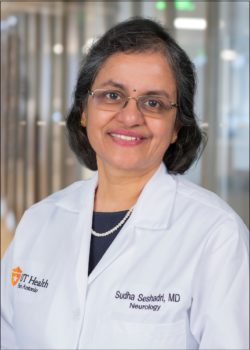Participants’ blood samples were drawn years before their dementia diagnosis.
Sudha Seshadri, M.D., founding director of the Glenn Biggs Institute for Alzheimer’s & Neurodegenerative Diseases at UT Health San Antonio, is co-leader and senior author on research announced March 6 that identifies novel biomarkers of risk for future dementia.
Dementia is a rising tidal wave of devastation for families and society. Age is the biggest risk factor. Alzheimer’s disease, which is the leading cause of dementia, is the sixth-leading cause of death in the United States, and more than 5 million Americans are currently living with Alzheimer’s. That figure is expected to triple by 2050.
The discovery is described in Alzheimer’s & Dementia: The Journal of the Alzheimer’s Association. The study analyzed small molecules called metabolites in blood samples drawn from 22,623 individuals, including 995 who went on to develop dementia. The p
articipants were enrolled in eight research cohorts in five countries.
Associations with lower, higher risk

Researchers found that higher blood concentrations of molecules called branched-chain amino acids were associated with lower risk of future dementia. Another molecule, creatinine, and two very low-density lipoprotein (VLDL)-specific lipoprotein lipid subclasses also were associated with lower risk of dementia.
One high-density lipoprotein (HDL) and one VLDL lipoprotein subclass were associated with increased dementia risk.
These findings will broaden the search for drug targets in dementia caused by Alzheimer’s disease, vascular disease and other subtypes, said Dr. Seshadri, professor of neurology at UT Health San Antonio. Formerly of Boston University, Dr. Seshadri is a senior investigator in the long-running Framingham Heart Study and leads the neurology working group within several international consortia.
“It is now recognized that we need to look beyond the traditionally studied amyloid and tau pathways and understand the entire spectrum of pathology involved in persons who present with symptoms of Alzheimer’s disease and other dementias,” Dr. Seshadri said. “It is exciting to find new biomarkers that can help us identify persons who are at the highest risk of dementia.”
Diagnostic exam
In the future, the Glenn Biggs Institute may investigate the feasibility of developing a diagnostic exam, such as a blood test, to assess each patient’s molecular signature of dementia risk. The signature could include blood concentration of branched-chain amino acids. The altered metabolite signatures were observed years before the diagnosis of dementia when those study participants were healthy, Dr. Seshadri said. If a test were to become available, therapy could be initiated earlier.
The study was in persons of European ancestry and was carried out in collaboration with researchers in Finland, the Netherlands, the United Kingdom and Estonia. Dr. Seshadri is eager to replicate it in South Texas. “The Glenn Biggs Institute at UT Health San Antonio will expand these studies to include the diverse racial and ethnic groups who live in South Texas,” she said.
Branched-chain amino acids are nutrients that the body obtains from proteins in foods such as meat and legumes. These amino acids include leucine, isoleucine and valine. “Valine has previously been shown to be involved in determining the risk of diabetes, which is a particularly big problem in our region, especially among the region’s large Hispanic population,” Dr. Seshadri said. “Now it is shown to be associated with the risk of Alzheimer’s dementia. We want to investigate for any connections.”
Lifestyle modifications
Metabolites are influenced by genetic and environmental factors, and their levels can be modified through dietary and pharmacological interventions. “I hope that people reading about this study will understand that they can take ownership of their health,” Dr. Seshadri said. “The lifestyle decisions they make, such as adopting a Mediterranean or other healthful diet, can affect these metabolites in ways we do not fully understand.”
Further studies can clarify whether the branched-chain amino acids and other molecules play a causal role in the dementia disease process or are merely early markers of the disease, Dr. Seshadri said.
Glenn Biggs Institute
The Glenn Biggs Institute for Alzheimer’s & Neurodegenerative Diseases was announced by William L. Henrich, M.D., MACP, president of UT Health San Antonio, in September 2015. Named in honor of San Antonio businessman Glenn Biggs, the Biggs Institute was established to address the community’s need of a comprehensive center for neurodegenerative disease research and care. Community donors gave more than $50 million to stand up the institute. Dr. Seshadri, internationally respected dementia research leader from Boston University, began duties Dec. 1, 2017, as founding director of the Glenn Biggs Institute.
The University of Texas Health Science Center at San Antonio, with missions of teaching, research and healing, is one of the country’s leading health sciences universities and is now called UT Health San Antonio™. UT Health’s schools of medicine, nursing, dentistry, health professions and graduate biomedical sciences have produced more than 33,000 alumni who are advancing their fields throughout the world. With seven campuses in San Antonio and Laredo, UT Health San Antonio has a FY 2018 revenue operating budget of $838.4 million and is the primary driver of its community’s $37 billion biomedical and health care industry. For more information on the many ways “We make lives better®,” visit www.uthscsa.edu.


